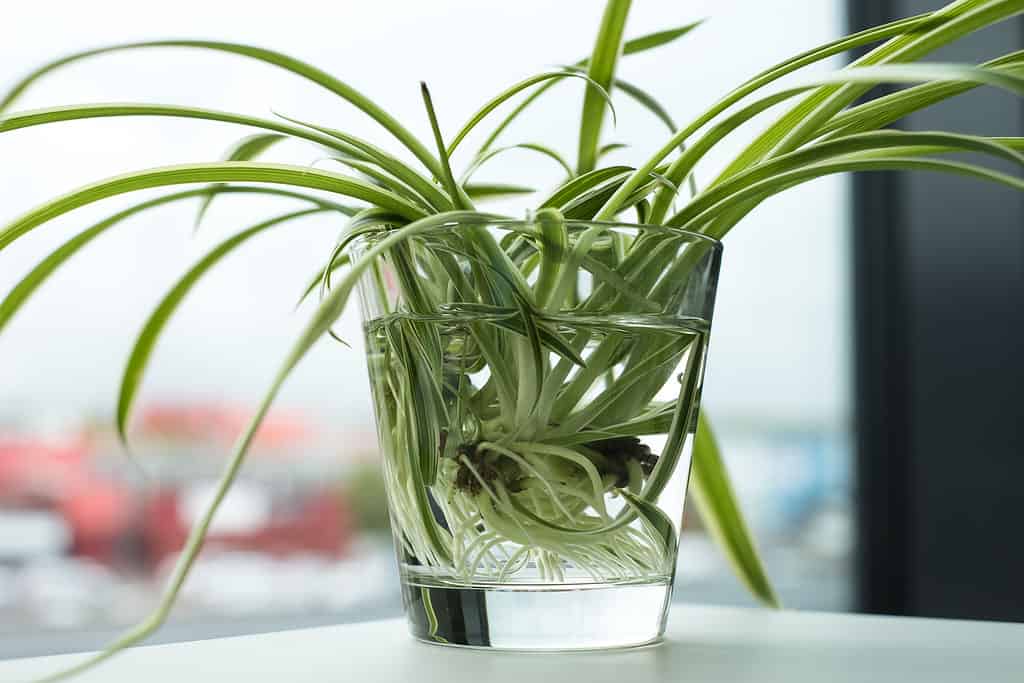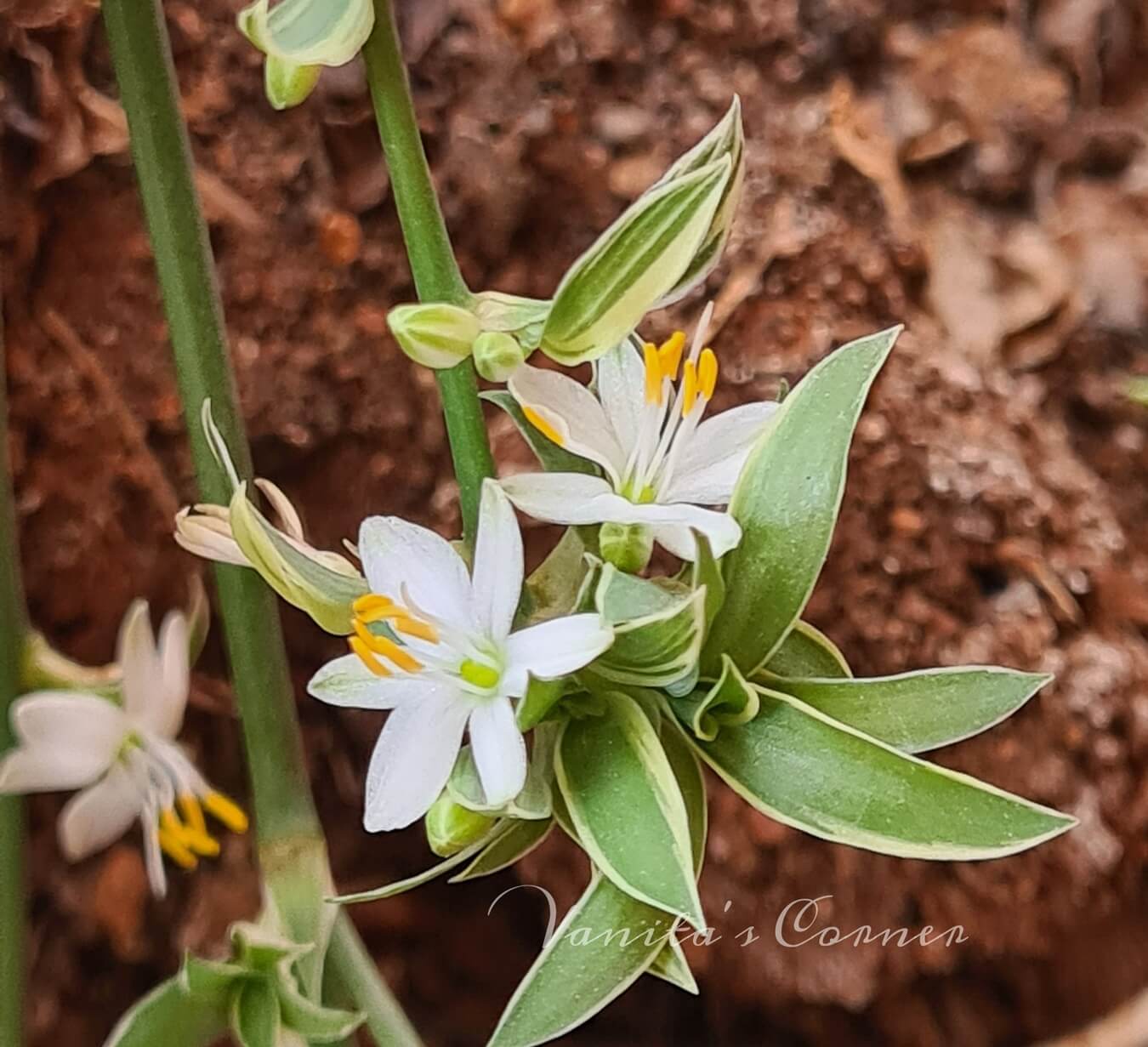
The Spider or Ribbon plant is one of the best and most decorative performers amongst my indoor plant collection. It’s sassy, it’s sexy and I love it to bits. Why? It’s tough, it’s resilient, and has been around since forever, which aptly speaks for its hardiness and its ease of care. And as I often declare, you can never enough of them. I have more than two dozen plants hanging outside and another dozen or so in single pots which live on high shelves both inside and outside.
My love affair for the spider plant began many years ago. A few months after I purchased my present house and garden, I discovered a single specimen living quite merrily under my long staircase which leads up to my first floor verandah. Basically, the area was a dumping ground for old, shattered pots, broken bricks and discarded unusable large ugly rocks. Out of sight, out of mind. The soil was non-existent and rarely if ever received any sun, rain or moisture. It had survived total neglect outside through hot summer days and freezing winter temperatures. It was a miracle it had ever survived. It was a true lesson and full testament to its toughness and longevity no matter what conditions. I promptly potted it up and from this first neglected specimen my collection began.

History
Chlorophytum comosun is a member of the Liliaceae family.it comes from South Africa and was first introduced as an indoor plant in the mid nineteenth century to Europe and America. The Latin name Chlorophytum means green leaves which originally it had. The variety now universally grown is C. comosun ‘Variegatum’, that has a prominent white stripe down the entire long length of its leaves, thus one of its common names the ribbon plant. There are newer cultivars, one with wider and fatter leaves, another with tightly twisted, curled leaves, and a smaller miniature leaved variety.
Description
During the active growing season, the spider plant throws out long cream stems, 30cm to 60cm in length, adorned with small six petalled white flowers, called spiderettes, which collectively resemble a mass of starry constellations. These in turn are succeeded by plantlets with miniature versions of the parent plant appearing either singly or in groups. These plantlets weigh down the stems as they develop, rapidly producing roots, which in nature would grow into the soil around the parent.
Design
Their unique long striped white and green ribbon leaves and their accompanying spiderettes which grow, descend and hang heavy around the parent plant, make them the ideal candidate for hanging baskets. This added height gives you the perfect opportunity to fully admire their decorative magical majesty. En masse, say 5 or more all in a row, or even staggered, the effect is superbly beautiful and so simply easy to achieve. In addition, their ribbon shaped leaves can create stunning foliage contrasts, through colour, shape, size and texture with other hardy indoor plants such as Ficus, Monsteras and Aspidistras. The list is truly endless and is only limited by your own imagination and savviness as a decorator.
Cultivation
Like many of the hardiest plants they can survive practically anything. They are very tolerant of drought and neglect and will not die if you occasionally forget them. In fact, some say, dryness may actually encourage them to produce more stems, flowers and plantlets. They are very tolerant of dark places but given good light they respond exponentially in their performance. Ideally you should keep the soil mostly moist during the spring and summer, watering 2 to 3 times a week but only once a fortnight in winter. Feeding with a soluble indoor plant fertiliser once a fortnight is strongly recommended. You can clean the leaves by spraying them all over with tepid water from a mist sprayer. They grow well in water and convert easily to hydroculture. In extreme cold weather with heavy frosts, the leaves may indeed melt but in spring the foliage quickly bounce back to their former glory.

Hanging baskets are notorious for the soil to quickly dry out. So what basket is the best? I don’t especially like plastic hanging pots, for they look a bit ordinary, even ugly. However, they are better suited for holding water and also possess an attached saucer, which provides an extra reservoir of moisture. I much prefer the baskets with a metal framework lined with coco fibre, looking far more natural and aesthetically pleasing. Alas they are not in the least bit practical. In short time, the fibre shrinks and deteriorates, and they cannot hold the necessary water. Thus, to solve this problem I always line them with plastic, with enough holes to guarantee good drainage.
Propagation
As the plantlets grow larger leaves and aerial roots, they can be planted beside the parent plant and after about 6 weeks the stem can be cut away. I rarely if ever follow this method. I just cut the descending stem of the plantlet and directly plant it in soil or water. You can also propagate by root division, but I find it a rather messy affair and the plant takes some time to recover.
Happy gardening and have fun,
Regards Ned McDowell.